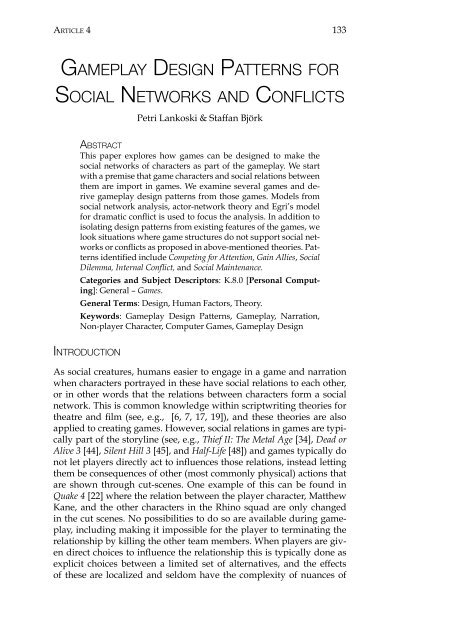Character Driven Game Design
Character Driven Game Design
Character Driven Game Design
You also want an ePaper? Increase the reach of your titles
YUMPU automatically turns print PDFs into web optimized ePapers that Google loves.
Article 4 133<br />
<strong>Game</strong>play <strong>Design</strong> Patterns for<br />
Social Networks and Conflicts<br />
Petri Lankoski & Staffan Björk<br />
Abstract<br />
This paper explores how games can be designed to make the<br />
social networks of characters as part of the gameplay. We start<br />
with a premise that game characters and social relations between<br />
them are import in games. We examine several games and derive<br />
gameplay design patterns from those games. Models from<br />
social network analysis, actor-network theory and Egri’s model<br />
for dramatic conflict is used to focus the analysis. In addition to<br />
isolating design patterns from existing features of the games, we<br />
look situations where game structures do not support social networks<br />
or conflicts as proposed in above-mentioned theories. Patterns<br />
identified include Competing for Attention, Gain Allies, Social<br />
Dilemma, Internal Conflict, and Social Maintenance.<br />
Categories and Subject Descriptors: K.8.0 [Personal Computing]:<br />
General – <strong>Game</strong>s.<br />
General Terms: <strong>Design</strong>, Human Factors, Theory.<br />
Keywords: <strong>Game</strong>play <strong>Design</strong> Patterns, <strong>Game</strong>play, Narration,<br />
Non-player <strong>Character</strong>, Computer <strong>Game</strong>s, <strong>Game</strong>play <strong>Design</strong><br />
Introduction<br />
As social creatures, humans easier to engage in a game and narration<br />
when characters portrayed in these have social relations to each other,<br />
or in other words that the relations between characters form a social<br />
network. This is common knowledge within scriptwriting theories for<br />
theatre and film (see, e.g., [6, 7, 17, 19]), and these theories are also<br />
applied to creating games. However, social relations in games are typically<br />
part of the storyline (see, e.g., Thief II: The Metal Age [34], Dead or<br />
Alive 3 [44], Silent Hill 3 [45], and Half-Life [48]) and games typically do<br />
not let players directly act to influences those relations, instead letting<br />
them be consequences of other (most commonly physical) actions that<br />
are shown through cut-scenes. One example of this can be found in<br />
Quake 4 [22] where the relation between the player character, Matthew<br />
Kane, and the other characters in the Rhino squad are only changed<br />
in the cut scenes. No possibilities to do so are available during gameplay,<br />
including making it impossible for the player to terminating the<br />
relationship by killing the other team members. When players are given<br />
direct choices to influence the relationship this is typically done as<br />
explicit choices between a limited set of alternatives, and the effects<br />
of these are localized and seldom have the complexity of nuances of
















